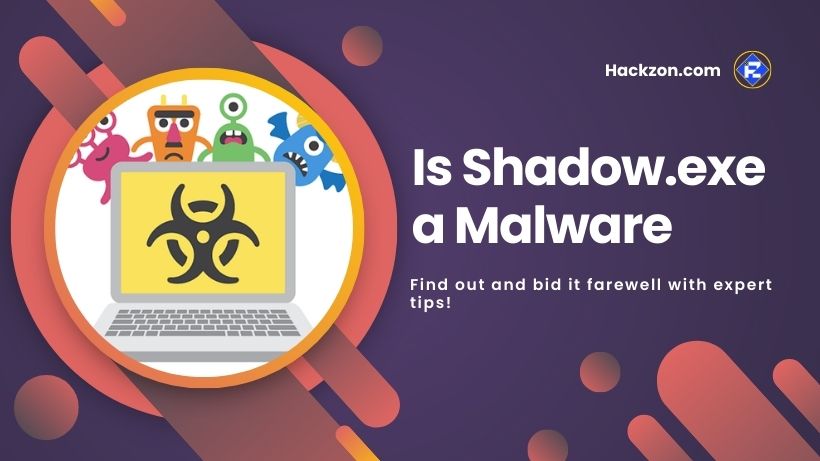Virus
Is Shadow Exe a Virus or Malware? How to Remove It?

Have you ever encountered a suspicious file named “Shadow exe” on your computer and wondered whether it’s a harmless file or a potential threat?
The digital world can be full of surprises, and sometimes that includes encountering suspicious files like Shadow.exe or KillerNetworkService.exe on your computer! But fear not!
In this helpful article, we’ll look closely at Shadow exe to see if it offers any concerns as a virus or malware.
We’ll equip you with essential knowledge about identifying and removing Shadow exe if it poses a security risk to your system. Let’s shed some light on this mysterious file and safeguard our digital space.
Overview of Shadow Exe
Shadow.exe is an executable file in the NTI Shadow for ReadyNAS Software by a Microsoft Windows Operating System software developer linked with the Session Remote Control Utility process.
Users should proceed cautiously with this process since it might be critical to the Windows Operating System.
On the other hand, excessive CPU or GPU utilization might be symptomatic of potential malware or virus activity, primarily if the process operates in the background.
The.exe extension indicates that it is designed for Windows operating systems such as Windows XP, Windows 7, Windows 8, and Windows 10.
As a result, it is critical to correctly recognize and handle Shadow exe to ensure the system’s security and performance.
Is Shadow Exe a Virus or Malware?
We must be vigilant about malware and viruses communicated by exe files before executing any unfamiliar executable file on our PCs or laptops.
This overview investigates if Shadow exe is a virus or malware. If the developer is genuine, it is probably safe; otherwise, uninstallation using the uninstall program may be required if doubts emerge.
Learn more about evaluating whether Shadow exe is a danger, how to resolve any related issues, and whether it may hurt your Windows PC’s performance.
Gain insight into any process’s lifecycle stages, from start to finish. Make educated decisions to keep your PC safe.
Can We Remove or Delete Shadow Exe?
We do not recommend uninstalling shadow exe from your Windows system due to its safety and necessity.
Because it is a critical system process, disabling or eliminating it may create issues with vital programs.
System processes like shadow exe are essential in controlling different operating system operations, including memory, networking, and display like TwDsUiLaunch.exe.
Instead of destroying it for no reason, maintain your program up to date to avoid problems with damaged data.
While some people have erased this file, it is critical to verify its authenticity before taking any action. A system analysis using Reimage can assist in diagnosing and resolving any issues with shadow exe.
How to Identifying the Legitimacy of Shadow.exe?

Before proceeding with the deletion, ensure that it is not a virus. There’s no need to uninstall it if it turns out to be virus-free.
However, if it is malware or another type of file, it must be removed immediately.
1. File Location
First, look for the file on your machine. Legitimate system files are often stored in locations such as “C: Program Files (x86)NewTech InfosystemsNTI Shadow for ReadyNAS”.
Shadow exe may be a reason for worry if it is discovered in an unusual place or nested within mysterious directories.
2. Digital Signature
Genuine software frequently includes a valid digital signature from the developer. Right-click the file and choose “Properties.”
Look for a digital signature; if it is missing or looks invalid, it may signal a possible threat.
3. Check File Properties
Look at the file’s properties to learn more. Take note of facts such as file size, version, and publisher. If this information appears suspicious or out of place with the anticipated numbers, it’s time to dig further.
4. Scan With Antivirus Software
Run a comprehensive scan of the file with reliable antivirus software. A trustworthy antivirus program can identify malware and offer information about the possible threats linked with Shadow exe.
How to Remove or Uninstall Shadow Exe?
To remove or uninstall Shadow exe, follow these steps,
- Uninstall Rescue and Recovery from your computer by using MsiExec.exe /I7726CF62-7B45-4E6D-9266-615346816BCA.
- If the uninstaller cannot be found, remove Rescue and Recovery using the Add/Remove Programmes option in the Windows Control Panel.
- Open Control Panel and navigate to Programmes from the Start menu (or right-click the bottom-left corner of Windows 8).
- Click “Uninstall a Programme” in Windows Vista/7/8.1/10; on Windows XP, click “Add or Remove Programmes.”
- Navigate to Rescue & Recovery, then select “Uninstall” (for Windows Vista/7/8.1/10) or the “Remove” or “Change/Remove” option (for Windows XP).
- Follow the on-screen instructions to completely erase Rescue and Recovery and eliminate Shadow exe from your system.
Closing
The process of analyzing the nature of Shadow exe has been eye-opening. By studying and grasping its credibility, we can protect our digital space from possible dangers.
Remember to do an in-depth investigation, run security scans, and, if necessary, follow correct removal procedures. You can successfully traverse the world of computer data and keep your system secure with the proper knowledge and prudence.
Stay vigilant!!
















